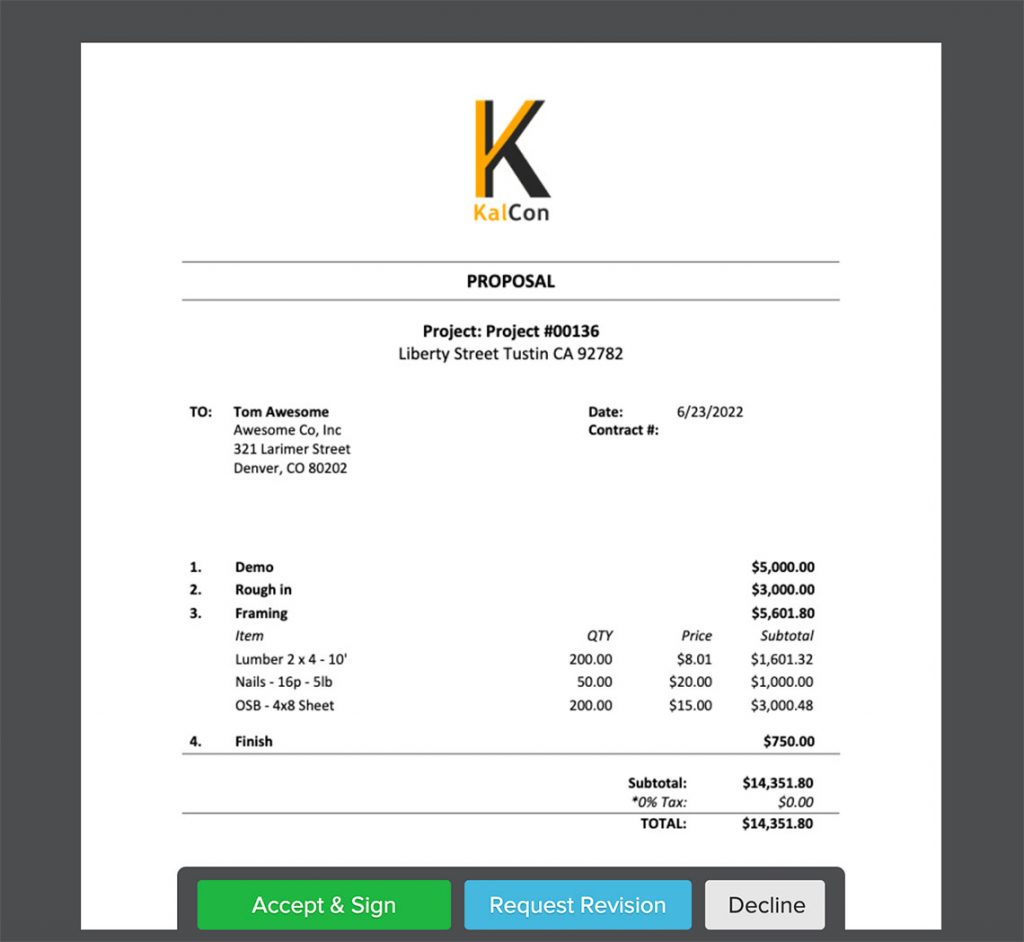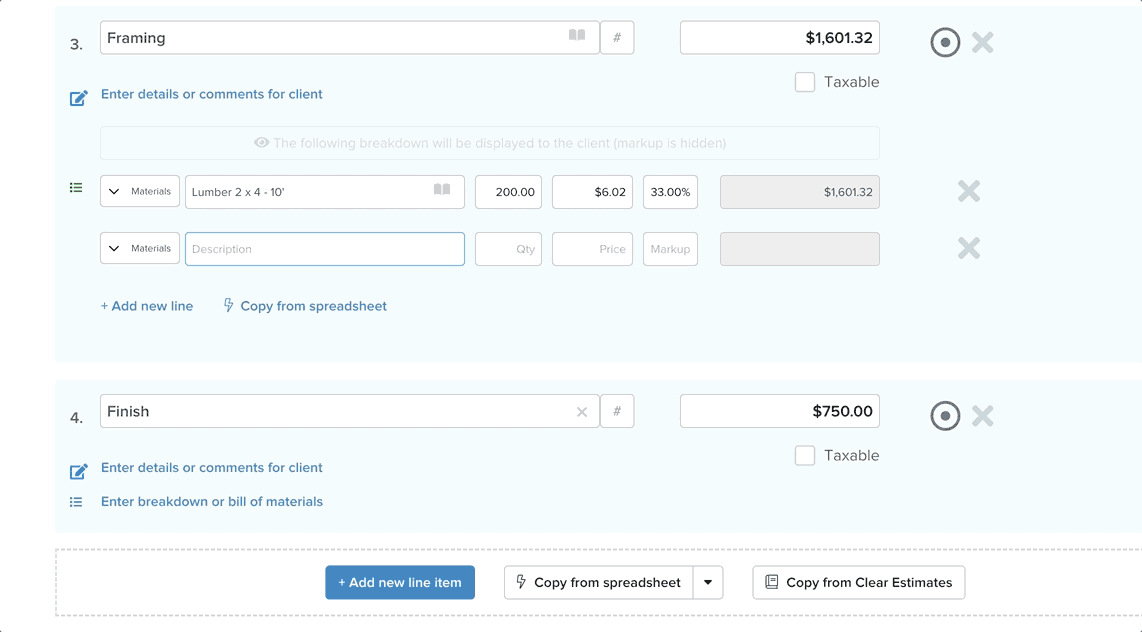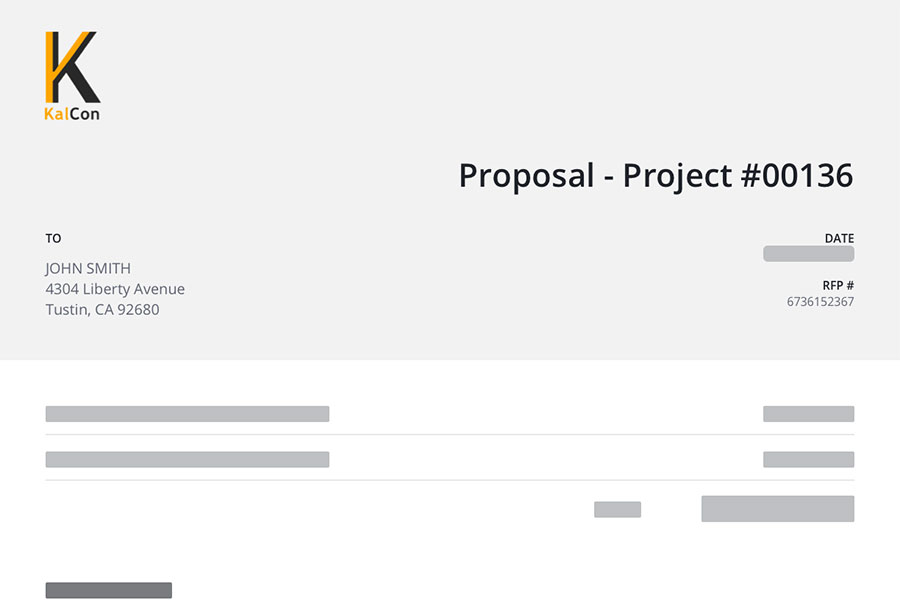Getting started: Set yourself up for success
A great proposal is crucial to win business, especially for growing contracting businesses. By using a generic or unoptimized proposal for your bids, you could be leaving potential profit on the table.
Learning how to write a construction proposal that stands out from the competition and conveys trust can help you win more contracts and improve profitability. This guide will teach you key elements that can help elevate your company’s proposals, introduce you to valuable tools to streamline your workflow like construction proposal software, and set yourself up to win more business.
But before we get into it, it’s important to point out the differences between a construction bid and a construction proposal. A construction bid specifically outlines the estimated cost to complete a project and serves as a competitive document for clients evaluating multiple offers.
What is a construction proposal?
A construction proposal is a comprehensive document that outlines the scope of work, timeline, budget, and other essential information for a construction project. It serves as a crucial tool for construction companies to win bids and secure projects.
A good construction proposal showcases a company’s skills, expertise, and reputation, helping to avoid conflicts and misunderstandings during the project. By clearly defining the project details, a construction proposal ensures that both parties have a mutual understanding of the expectations and deliverables.
Why are construction proposals important?
Construction proposals are essential for several reasons. They provide a clear and detailed outline of the project’s scope, timeline, and cost, ensuring that both the construction company and the client have a shared understanding of what will be delivered and at what cost. A well-written construction proposal demonstrates transparency in pricing and cost breakdown, which can help build trust with the client.
Additionally, a construction proposal serves as a foundation for project planning and execution, helping the construction company allocate resources, plan schedules, and coordinate tasks effectively. This level of detail and clarity can significantly enhance the chances of project success and client satisfaction.
What sections should I include?
Determining the right format and sections for your construction project proposals will depend on your specific business model. No matter what trade you specialize in, every niche has its own requirements and information to lay out in order to successfully win business.
Here is a list of common sections you may want to consider including in your construction project proposal.
- Introduction
- Project summary
- Project timeline
- Financial investment
- Next steps
24 hours
On average, a proposal could take 24 hours to complete, or about 17.5 minutes per question.
5 hours
The average turnaround time for small companies completing a proposal.
How do I stand out?
Creating an effective construction proposal is a crucial element in increasing your win-rate for jobs within the competitive construction industry. A well-crafted proposal not only serves as a communication tool but also acts as a significant selling point for construction companies.
- Accuracy: Take your time to ensure the information you are providing is correct and fully addresses the questions or concerns your client may have.
- Clear branding: While it’s tempting to create a proposal in Word or from a prefabricated template, this doesn’t create a memorable image for your brand. By taking a few extra minutes to alter the font, include your logo, add splashes of your brand color(s), or a mission statement, you’ll form an identity that distinguishes your proposal from others.
- Ease of revision requests: Are you guilty of sending information in email chains and difficult to source links and files? This can create confusion, misunderstandings, and hassle for the client that may deter them from doing business with you. Make sure potential clients can review and request edits to your proposal in a central, secure location that’s accessible to any key decision makers.
- Ease of signature: This may seem obvious, but if your contracts are difficult to understand, read, and sign off on, you’ll have a harder time closing the agreement. Consider switching to a platform with electronic signature for any important documents. This will also give you notification and reminder options to ensure the documents are sent and signed off on correctly.
- Responsiveness: Not to be confused with speed of information gathered, the responsiveness of your team to questions, comments, and concerns can greatly improve your chances of winning a contract – or losing one. Be sure to check your inbox and voicemail daily and respond within 24 hours to any client communications, even if it’s simply to say you need a bit more time to source that information and will send updates as it becomes available. And wherever possible, create a firm date and time to which you will provide an update on the information requested.

The first impression: Introduction
First impressions form quickly and can be lasting in business. That’s why it’s important to start every construction bid proposal with your best foot forward. Take the time to explain who you are, why you’re interested in the project, your company’s background, and provide referrals who can vouch for the caliber of your work. This can be done using all or some of the following sections of your construction bid proposal:
- Cover page
- Cover letter
- About our company
- References or testimonials
How do I stand out?
- Personalization: Take the time to do your homework. Who is the decision maker of this project? If you can’t find this information, find ways to incorporate their brand and specific details of the project into your proposal. By including things like brand names, the names of decision makers, and your point of contact’s name and information, you get one step closer to creating a strong working relationship with your potential client.
- Bonus points: digitize your actual signature to insert into the proposal. You can easily create a digital signature by using a tablet, stylus, and free software online.
- Tell a story: To convey trustworthiness, you’ll want to elaborate on why you’re the best person for the job. Have you worked on a similar project before? Share some project examples! Do your clients love the work you provide? Let them know with testimonials and former client references that they can contact. These actions show rather than tell that you are reliable and trustworthy.
Did you know?
Employee satisfaction is only tracked in approximately 14% of construction companies. However, satisfied employees correlates with higher win rates. So, if you want to improve your bid-to-win ratio, make sure employee morale and satisfaction isn’t overlooked.
The summary: Project details and description
Now that your potential client has an idea of who you are and your credibility, you can begin to explore logistics. With every construction project having unique requirements, it can be overwhelming knowing where to start. Understanding how to write a construction proposal summary depends on the type of project and work your team will provide. Here are some examples of subsections to include in your project summary section.
- Project scope or project overview
- Plans and permits
- Expectations
- Exclusions
- Line items
- Project examples
- Roles and responsibilities
- Initial walk-through, evaluation, or inspection summary

How do I stand out?
- Be transparent: It’s just as important in your construction proposal to say what you aren’t including in your scope of work as what is included. This can help you avoid potential disagreements or misunderstandings down the line.
- Be detailed: If the project remains loosely outlined, it can easily veer off track. This is your opportunity to provide meticulous, properly vetted project details, steps, and deliverables, including who will do it, how they will do it, and what they will use. When in doubt, it’s best to write it out.
The project timeline: Schedule and phases
With your scope of work fleshed out, you can begin to construct a schedule for project completion. Consider using a construction proposal or construction schedule template as a starting point. It’s often easier to modify something that already exists than start from scratch. This also is where the old saying “under promise and over perform” can really come in handy. A fully fleshed out project timeline should include:
- Phase overview with deadlines (if applicable)
- Estimated project completion deadline
How do I stand out?
- Give yourself plenty of time: According to KPMG, only 25% of construction projects have come within 10% of their original deadlines in the last 3 years. By building in plenty of time for unexpected delays or errors, you’ll create a track record of hitting deadlines.
The investment: Financial overview and expectations
Finances are a sensitive subject for many. And while it may be tempting to offer the lowest prices as a means of competing with other companies, this strategy can lead to fewer wins overall, as well as profitability concerns. Be sure to consider the following when building out your budget.
- Material cost overview
- Labor cost overview
- Permits and fees
- Contingency
- Warranty
- Insurance
- Total financial estimate
How do I stand out?
- Don’t undersell your services: Only 31% of construction projects came within 10% of their original budgets in the last 3 years. This can account for why nearly 60% of contractors are putting in higher bids for projects.
- Emphasize trust: A strategically placed testimonial following your estimate can help to remind potential clients about your prior project success, client satisfaction, and trustworthiness.
The close: Next steps and agreement
Great news – if your potential client has made it this far, you’ve already made it through some large obstacles. In order to move your contract from pending approval to completion, consider the following options.
- E-signature capabilities
- Proposal summary with payment schedule
- Terms and conditions section
How do I stand out?
- Easy to understand payment details: To ensure there is no confusion regarding when you get paid and how, make sure it is explicit within your proposal. If these are laid out within terms and conditions, it may be beneficial to highlight the specific page or section in which this information lives. This will help your client easily track this information and provide coverage for your team’s billing and accounting team.
Common mistakes to avoid in construction proposals
When writing a construction proposal, there are several common mistakes to avoid:
- Using unclear language: Ambiguity can cause confusion about project scope, responsibilities, and expectations. Ensure your language is precise and easy to understand.
- Failing to specify payment terms clearly: Include the total project cost, payment milestones, and terms for handling additional costs or changes to the project scope.
- Using non-customizable templates: Generic templates can limit your ability to tailor your bid to the specific needs and preferences of the project and client. Customize your proposal to stand out.
- Not including a detailed scope of work: A vague scope can lead to misunderstandings and disputes during the project. Be thorough in outlining what is and isn’t included.
- Not providing a clear project timeline: Without a well-defined timeline, projects can face delays and cost overruns. Detail each phase and set realistic deadlines.
Using a construction proposal template
A construction proposal template can be a useful tool for creating a comprehensive and effective proposal. A good template should include all the necessary elements, such as:
- Executive summary: A brief overview of the project and your company’s qualifications.
- Detailed scope of work and project proposal: Clearly outline the tasks, responsibilities, and deliverables.
- Cost estimate: Provide a detailed breakdown of costs, including materials, labor, permits, and contingencies.
- Payment schedule and project timeline: Specify payment milestones and a realistic timeline for project completion.
- Terms and conditions: Outline the legal and contractual obligations of both parties.
- Relevant authorities: Include any necessary permits or approvals required for the project.
- Warranty: Detail any warranties or guarantees offered.
- Owner information and acceptance: Include spaces for the client’s information and signature.
- Social proof: Add testimonials or references to build credibility.
Using a template can help you save time and ensure that your proposal is well-organized and easy to read. However, it’s essential to customize the template to fit the specific needs and requirements of the project and client. Tailoring your proposal demonstrates attention to detail and a commitment to meeting the client’s unique needs, which can set you apart from the competition.
Conclusion
Learning how to write a construction proposal that’s thorough and memorable makes life easier for all parties involved. Taking the time to be clear, accurate, and personal can make the difference between a successful bid and one left unanswered. However, you don’t need to start from scratch when it comes to making proposals. Software like Knowify exists to reduce repetitive tasks and increase efficiency in all areas of the construction proposal and project management process.
Thinking of taking the next step to improve your processes through digital tools? You’re not alone! 40% of SMBs in the construction industry want to buy or upgrade their software in the next 12 months. Why not explore a complete, end-to-end construction management solution like Knowify?
Ready to learn more? Schedule a personalized demo today!
